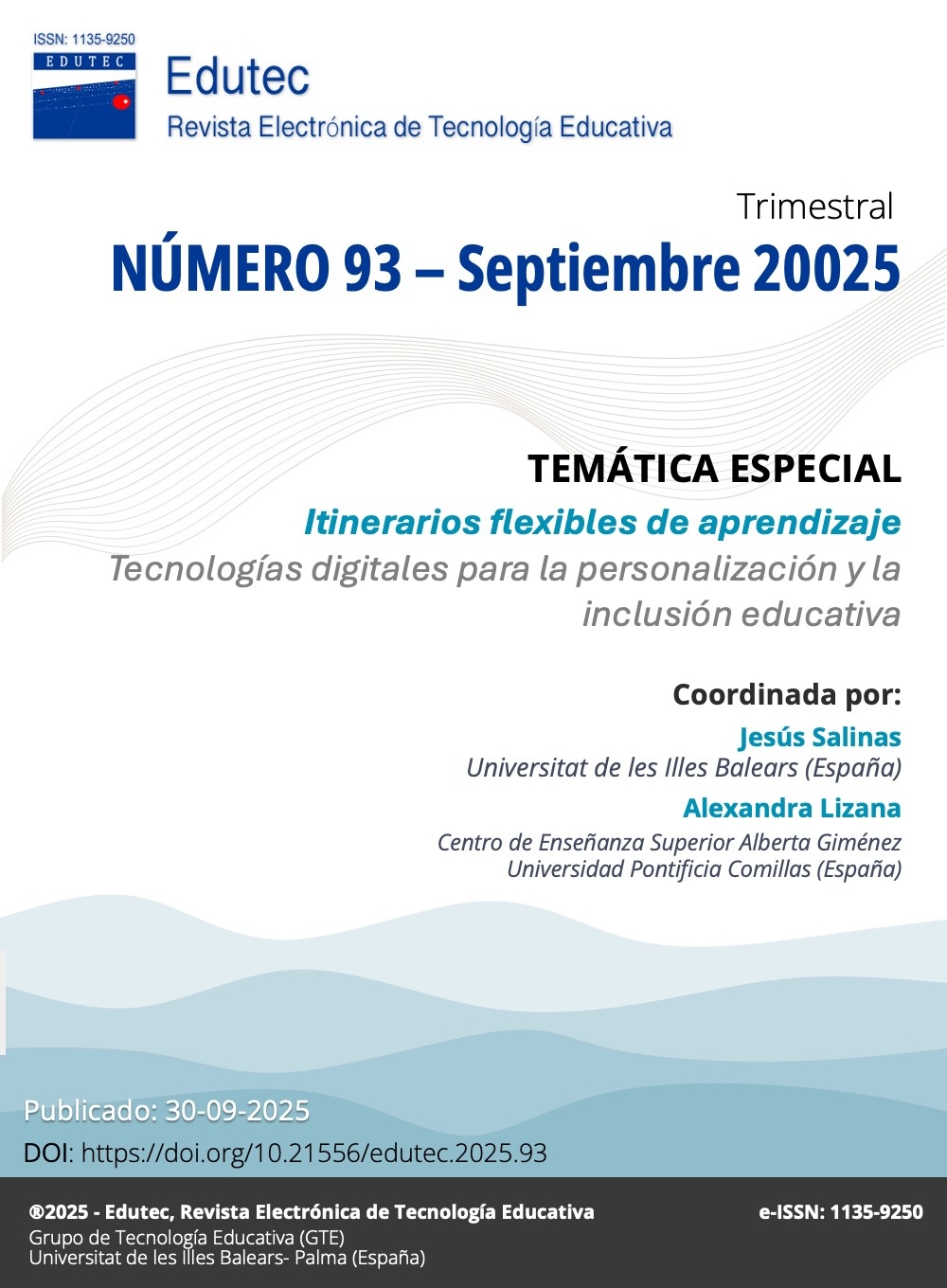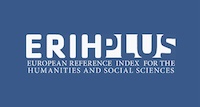Attention economy: A study on digital content consumption patterns in university students
DOI:
https://doi.org/10.21556/edutec.2025.93.3921Keywords:
smartphones, digital consumption, attention economy, social media, informal learningAbstract
The perspective of the attention economy recognizes how digital platforms shape consumption habits through algorithmic personalization and content segmentation. This study analyzes content consumption behaviors through smartphones among students of the Faculty of Administrative Sciences and Digital Technologies at UNICACH, aiming to describe the average consumer profile and usage patterns based on a descriptive quantitative methodology.
The results show that social media and entertainment platforms dominate mobile device usage, but they also reflect a growing convergence between leisure and learning. Immediacy and interactivity influence content selection, while available time and academic workload modulate these patterns. However, the high presence of leisure content on social media can lead to distractions that impact concentration and academic performance.
The findings suggest the need to design educational strategies that integrate these technologies in a balanced way, maximizing their pedagogical potential without overlooking the risks associated with attention dispersion.
Downloads
References
Anderson, M., & Jiang, J. (2018). Teens, social media & technology 2018. Pew research center, 31(2018), 1673-1689.
Anderson, M., Faverio, M., & Gottfried, J. (2023). Teens, social media and technology 2023. Pew Research Center. https://www.pewresearch.org/wp-content/uploads/sites/20/2023/12/PI_2023.12.11-Teens-Social-Media-Tech_FINAL.pdf
Asociación de Internet MX. (2022). 18° Estudio sobre los hábitos de los usuarios de internet en México 2022. https://irp.cdn-website.com/81280eda/files/uploaded/18%C2%B0%20Estudio%20sobre%20los%20Habitos%20de%20Personas%20Usuarias%20de%20Internet%20en%20Mexico%202022%20%28Socios%29%20v2.pdf
Asociación de Internet MX. (2024). 20° Estudio sobre los hábitos de los usuarios de internet en México 2024. https://irp.cdn-website.com/81280eda/files/uploaded/20_Ha-bitos_de_Usuarios_de_Internet_en_Me-xico_2024_VP.pdf
Aubin Le Quéré, M., Naaman, M., & Fields, J. (2024). Not quite filling the void: Comparing the perceptions of local online groups and local media pages on Facebook. Proceedings of the ACM on Human-Computer Interaction, 8(CSCW1), 1-22. https://dl.acm.org/doi/10.1145/3637377 DOI: https://doi.org/10.1145/3637377
Blanca Mena, M. J., Alarcón Postigo, R., Arnau Gras, J., Bono Cabré, R., & Bendayan, R. (2017). Non-normal data: Is ANOVA still a valid option?. Psicothema, 2017, vol. 29, num. 4, p. 552-557. https://www.psicothema.com/pii?pii=4434 DOI: https://doi.org/10.7334/psicothema2016.383
Boglione, M. (2023). La economía de la atención: de la reconfiguración de las relaciones de poder al control social. Revista de Economía y Estadística, 61(1), 71-93. DOI: https://doi.org/10.55444/2451.7321.2023.v61.n1.44196
Competition and Markets Authority. (2020). Online platforms and digital advertising: Market study final report. CMA. https://assets.publishing.service.gov.uk/media/5efc57ed3a6f4023d242ed56/Final_report_1_July_2020_.pdf
Fernández-Rovira, C. (2022). Motivaciones y tiempo de uso de las redes sociales por parte de los jóvenes españoles: señales de adicción. Anuario Electrónico de Estudios en Comunicación Social “Disertaciones”, 15(2), 1-19. https://doi.org/10.12804/revistas.urosario.edu.co/disertaciones/a.11155 DOI: https://doi.org/10.12804/revistas.urosario.edu.co/disertaciones/a.11155
Gao, Y., Liu, F., & Gao, L. (2023). Echo chamber effects on short video platforms. Scientific Reports, 13(1), 6282. https://doi.org/10.1038/s41598-023-33370-1 DOI: https://doi.org/10.1038/s41598-023-33370-1
Gawer, A. (2021). Online Platforms: Societal Implications of the New Dominant Business Models of the Digital Economy. Berlin: Hertie School. https://www.denkfabrik-bmas.de/fileadmin/Downloads/Publikationen/Brief-1_Gawer_final_FINAL-ua.pdf
Giraldo-Luque, S. ; Fernández-Rovira, C. (2020). Redes sociales y consumo digital en jóvenes universitarios: economía de la atención y oligopolios de la comunicación en el siglo XXI. Profesional de la información. https://doi.org/10.3145/epi.2020.sep.28 DOI: https://doi.org/10.3145/epi.2020.sep.28
Hartmann, D., Wang, S. M., Pohlmann, L., & Berendt, B. (2025). A systematic review of echo chamber research: comparative analysis of conceptualizations, operationalizations, and varying outcomes. Journal of Computational Social Science, 8(2), 52. DOI: https://doi.org/10.1007/s42001-025-00381-z
Hernández Camblor, C., & Moral Jiménez, M. V. (2024). Uso de las redes sociales virtuales y su relación con la percepción de soledad y las habilidades sociales en jóvenes adultos españoles de la generación Z y la generación Y. Acta Colombiana de Psicología, 27(1), 229-245. https://doi.org/10.14718/ACP.2024.27.1.13 DOI: https://doi.org/10.14718/ACP.2024.27.1.13
Hernández-Sampieri, R., & Mendoza, C. (2020). Metodología de la investigación: las rutas cuantitativa, cualitativa y mixta. Editorial. Mc Graw Hill
Hendriks P. & Schaap G. (2023) An Attention Economic Perspective on the Future of The Information Age. Futures. https://www.researchgate.net/publication/373912844_An_Attention_Economic_Perspective_on_the_Future_of_The_Information_Age
Ikusiker (2025). Instagram y TikTok 2024-2025 Panel universitario. https://www.euskadi.eus/contenidos/noticia/keb_argit_ikusiker_53/es_def/adjuntos/Instagram-eta-TikTok_ES.pdf
McHugh, M. (2013). The chi-square test of independence. Biochemia medica. https://www.biochemia-medica.com/en/journal/23/2/10.11613/BM.2013.018/fullArticle DOI: https://doi.org/10.11613/BM.2013.018
Milli, S., Carroll, M., Wang, Y., Pandey, S., Zhao, S., & Dragan, A. (2025). Engagement, user satisfaction, and the amplification of divisive content on social media. PNAS nexus, 4(3). https://knightcolumbia.org/content/engagement-user-satisfaction-and-the-amplification-of-divisive-content-on-social-media DOI: https://doi.org/10.1093/pnasnexus/pgaf062
Observatorio Nacional de Tecnología y Sociedad Red (2023). Impacto del aumento del uso de Internet y las redes sociales en la salud mental de jóvenes y adolescentes. https://www.ontsi.es/sites/ontsi/files/2023-10/policybriefredesocialesaludmentaljovenesyadolescentes.pdf
Oliveros, D. (2024). Brecha digital de género: prácticas de consumo y construcción de la ciudadanía digital en Colombia. Revista de Psicología y Ciencias del Comportamiento de la Unidad Académica de Ciencias Jurídicas y Sociales, 15(Especial), 4-29. https://revistapcc.uat.edu.mx/index.php/RPC/article/view/483/460 DOI: https://doi.org/10.29059/rpcc.20241213-186
Organisation for Economic Co-operation and Development. (2022). The evolving concept of market power in the digital economy. OECD Publishing. https://www.oecd.org/content/dam/oecd/en/publications/reports/2022/05/the-evolving-concept-of-market-power-in-the-digital-economy_c384e80f/2cfcb4a8-en.pdf
Reardon, A., Lushington, K., & Agostini, A. (2023). Adolescent sleep, distress, and technology use: weekday versus weekend. Child and Adolescent Mental Health. https://acamh.onlinelibrary.wiley.com/doi/epdf/10.1111/camh.12616 DOI: https://doi.org/10.1111/camh.12616
Universidad de Ciencias y Artes de Chiapas. (2024). Memoria de la gestión universitaria 2021-2024. https://dgpe.unicach.mx//views/images/source/MEMORIA%202021-2024.pdf
Universidad de Ciencias y Artes de Chiapas.(s.f). Antecedentes. https://fcayted.unicach.mx/index.php?p=page&v=MjE=
Vombatkere, K., Mousavi, S., Zannettou, S., Roesner, F., & Gummadi, K. P. (2024). Tiktok and the art of personalization: investigating exploration and exploitation on social media feeds. In Proceedings of the ACM Web Conference 2024. https://doi.org/10.48550/arXiv.2403.12410 DOI: https://doi.org/10.1145/3589334.3645600
Xin Li, Hari Balasubramanian, Yan Chen, Chuan Pang (2024). Managing conflicting revenue streams from advertisers and subscribers for online platforms. European Journal of Operational Research, 314(1), 241-254. https://doi.org/10.1016/j.ejor.2023.10.024 DOI: https://doi.org/10.1016/j.ejor.2023.10.024
You, Y. , Yang-Huang, J., Raat, H., & Van Grieken, A. (2023). Factors of heavy social media use among 13-year-old adolescents on weekdays and weekends. World journal of pediatrics : WJP, 19(4), 378–389. https://doi.org/10.1007/s12519-023-00690-1 DOI: https://doi.org/10.1007/s12519-023-00690-1
Zahnow, R., Verrier, J., Hames, S., & Corcoran, J. (2024). Mapping and measuring neighbourhood social media groups. The case of facebook. Applied Geography. https://doi.org/10.1016/j.apgeog.2024.103415. DOI: https://doi.org/10.1016/j.apgeog.2024.103415
Zhou, R. (2024). Understanding the impact of TikTok’s recommendation algorithm on user engagement. International Journal of Computer Science and Information Technology, 3(2), 201-208. https://doi.org/10.62051/ijcsit.v3n2.24 DOI: https://doi.org/10.62051/ijcsit.v3n2.24
Published
How to Cite
Issue
Section
License
Copyright (c) 2025 Edutec, Revista Electrónica de Tecnología Educativa

This work is licensed under a Creative Commons Attribution 4.0 International License.
By submitting the paper, the authors assign the publication rights to the journal Edutec. For its part, Edutec authorises its distribution as long as its content is not altered and its origin is indicated. At the end of each article published in Edutec, the citation procedure is indicated.
The management and editorial board of Edutec Revista Electrónica de Tecnología Educativa do not accept any responsibility for the statements and ideas expressed by the authors in their work.
Translated with www.DeepL.com/Translator (free version)









